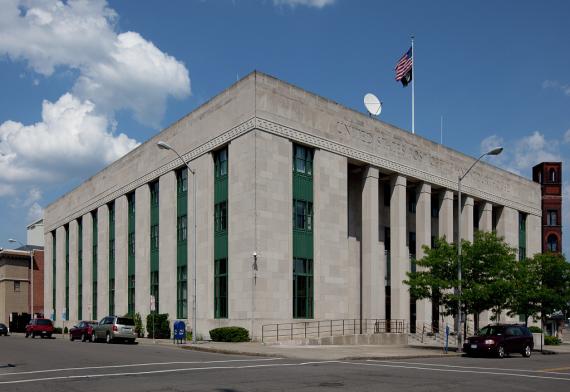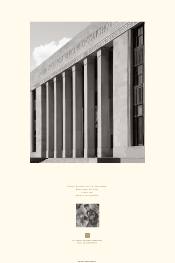Location: 15 Henry St, Binghamton, NY 13901
History
Completed in 1935 during the Great Depression, the Federal Building and U.S. Courthouse, originally called the U.S. Post Office and Courthouse, embodies the government’s desire to deliver a quality federal presence to growing American downtown despite economic challenges.
Binghamton’s earlier post office was located on the banks of the Chenango River, an area that by the early twentieth century was no longer convenient to the central business district developing closer to the Susquehanna River to the south. Property for the new federal building was acquired in 1916 for $100,000, but building plans ceased with the intervention of World War I. Further delays in authorization kept the project dormant until 1932.
The overall parameters of the building were overseen by Supervising Architect of the Treasury Louis A. Simon. The building’s construction was originally authorized under the Public Buildings Act of 1926 that allocated $165 million for the construction of new federal buildings across the country. However, the Keyes-Elliott Bill of 1930, an amendment to the 1926 act, permitted private firms such as local Binghamton firm Conrad and Cummings to compete for certain federal projects. This brief window of opportunity, welcomed by private firms during the Depression, ended in 1934 when government architects resumed responsibility for federal buildings.
The architecture firm of Conrad and Cummings was founded in 1926. Charles Conrad was educated at the Ecole des Beaux Arts and had designed institutional buildings such as the Binghamton Elks Lodge and the local Masonic Temple. Partner George Bain Cummings, who also specialized in institutional architecture, served as president of the American Institute of Architects from 1955 to 1956.
The construction contract was awarded in July 1934 and the building was completed in 1935. In 1967, post office operations relocated to a new facility. Portions of the building have been substantially remodeled, although the principal public areas retain many historic finishes. The building was listed in the National Register of Historic Places as a contributing building to the State Street - Henry Street Historic District in 1986.
Architecture
Louis A. Simon, superintendent of Treasury Department’s Architectural Division from 1905 to 1933, and its supervising architect from 1933 to 1939, advocated the credo, “moderne traditionalized, the traditional modernized.” As demonstrated upon the Federal Building and U.S. Courthouse, in the 1930s the government advocated a version of Classical architecture conveying dignity and authority but simplified in detail and materials. This reduced construction material and labor costs and simultaneously reflected the growing influence of Modernism and the exuberant Art Deco style. The Federal Building and U.S. Courthouse exemplifies this multivalent directive for public works projects initiated by the United States government during the Great Depression. The Art Deco influence is seen in the details animating the composition, while the formal distribution of elements references Classical architecture.
The steel-framed building’s principal cladding materials are Indiana limestone above a granite base; a common, economic, and durable combination typical of 1930s regional federal buildings. The U-shaped footprint of the four-story structure is also representative of its day. The basement and first floor covers the entire ground floor footprint, above which the building rises in three wings wrapping the central light court. This court is fenestrated with roof monitors and saw tooth skylights, illuminating the post office’s main workroom.
The building’s austere and temple-like facade consists of a seven-bay-wide, three-story colonnade surmounted by a continuous Greek key frieze. The centered entrance-way grouping is recessed behind the monumental lime-stone colonnade. Each of the three entries has a carved marble surround with inset panels of cast-iron semi-circular scallops set below larger panels each depicting an Art Deco styled American eagle.
The colonnade’s rhythm is sustained on the identical east and west elevations in alternating vertical bands of limestone and consistent fenestration. This is comprised of one tall and two shorter, identical windows, each separated by a fairly wide spandrel panel of cast iron Art Deco decoration with extruded scallops. The facade’s colonnade is flanked on each side by one unit of this window system. On the north, the original recessed loading dock was enclosed in 1960 and is now infilled with brick, creating a flush building plane up to the mezzanine level.
While much of the interior has been changed, two principal public areas, the lobby and the second floor courtroom, feature their original finishes. The range of marbles used in the lobby is striking, with a prominent use of American Pavanazzo, a green-veined white marble. Other notable details include the lobby’s original Deco-style bronze, copper, and glass pendant light fixtures. It is enriched with a field of brown terrazzo bordered by one-inch marble tiles and verde (green) antique marble. Commissioned by the Treasury Department Section of Fine Arts, eight murals painted by artist and Cornell University art professor Kenneth Leland Washburn (1904-1989) on the lobby’s upper walls depict scenes pertaining to local agriculture, industry, transportation, and the U.S. mail service.
The original entry doors into the double-height second floor courtroom are clad in vinyl with brass studs, brass kickplates, and oval windows. A paneled oak wainscot, beneath rhythmically placed paired and single wood pilasters, surrounds the courtroom. The judge’s bench, gallery benches and turned spindle court rail are original. Behind the judge’s bench, the entry to the judge’s chambers has a wood pediment detailed with fretwork and molding, supported by wood columns. The courtroom’s ceiling is paneled and features decorative cast iron grilles, also with fretwork, and original light fixtures.
Significant Events
- 1916: Property for a new federal building acquired
- 1932: Building authorized
- 1934-1935: Building constructed
- 1967: Post Office operations relocate
- 1986: Building listed in National Register of Historic Places as a contributing building to the State Street - Henry Street Historic District
Facts
- Construction Dates: 1934-1935
- GSA Building Number: NY0016ZZ
- Architect: Conrad and Cummings
- Landmark Status: Listed in the National Register of Historic Places
- Architectural Style: Neoclassical with Art Deco influences
- Primary Materials: Indiana limestone and granite
- Prominent Features: Three-story colonnade; Double-height courtroom with original finishes; Original lobby murals
Poster Download
Download the Poster [PDF - 235 KB]

 U.S. General Services Administration
U.S. General Services Administration

